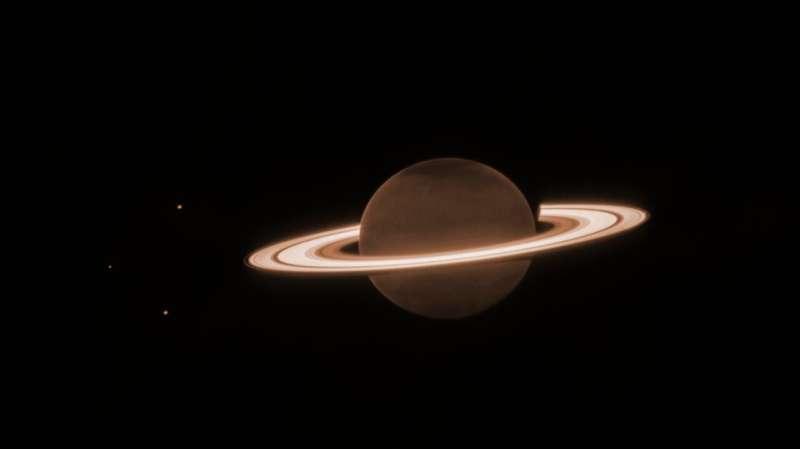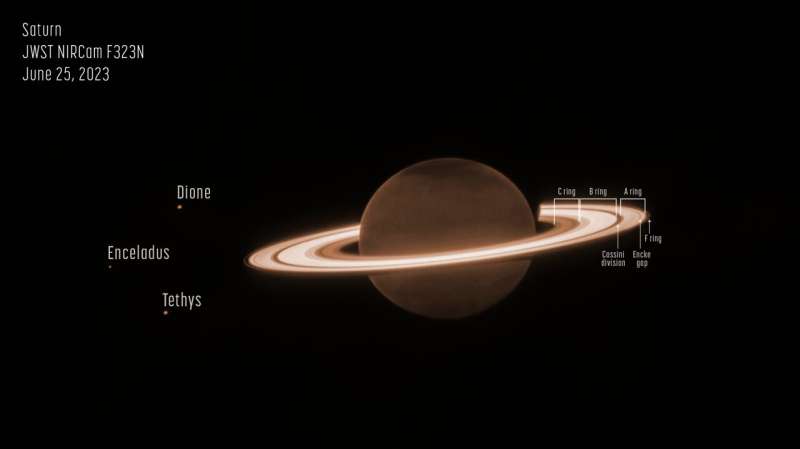This article has been reviewed according to Science X's editorial process and policies. Editors have highlighted the following attributes while ensuring the content's credibility:
fact-checked
trusted source
proofread
New image from James Webb Space Telescope reveals astonishing Saturn and its rings

Get ready to be amazed by the latest James Webb Space Telescope (JWST) image. Saturn's iconic rings seem to glow eerily in this incredible infrared picture, which also unveils unexpected features in Saturn's atmosphere.
This image serves as context for an observing program that will test the telescope's capacity to detect faint moons around the planet and its bright rings. Any newly discovered moons could help scientists put together a more complete picture of the current system of Saturn, as well as its past.
Methane gas absorbs almost all the sunlight falling on the atmosphere at this picture's specific infrared wavelength (3.23 microns). As a result, Saturn's familiar striped patterns aren't visible because the methane-rich upper atmosphere blocks our view of the primary clouds.
Instead, Saturn's disk appears dark, and we see features associated with high-altitude stratospheric aerosols, including large, dark, and diffuse structures in Saturn's northern hemisphere that don't align with the planet's lines of latitude. Interestingly, researchers previously spotted similar wave-like in early JWST NIRCam observations of Jupiter.
Unlike the atmosphere, Saturn's rings lack methane, so at this infrared wavelength, they are no darker than usual and thus easily outshine the darkened planet. This new image of Saturn also reveals intricate details within the ring system, showcasing several of the planet's moons like Dione, Enceladus, and Tethys.

"We are very pleased to see JWST produce this beautiful image, which is confirmation that our deeper scientific data also turned out well," said Dr. Matthew Tiscareno, a senior research scientist at the SETI Institute who led the process of designing this observation. "We look forward to digging into the deep exposures to see what discoveries may await."
Over the past few decades, missions like NASA's Pioneer 11, Voyagers 1 and 2, the Cassini spacecraft and the Hubble Space Telescope have observed Saturn's atmosphere and rings. The image captured by JWST is just a taste of what this observatory will uncover about Saturn in the coming years as scientists. This image is part of a suite of deeply exposed images where researchers hope to identify new ring structures and perhaps even new moons of Saturn.
Moving from the inner to the outer features of Saturn's rings, we can observe the dark C ring, the bright B ring, the narrow and dark Cassini Division, and the medium-bright A ring with the dark Encke Gap near its outer edge. Additionally, off the outer edge of the A ring, we can see the narrow strand known as the F ring. The rings cast a shadow on the planet and vice versa, creating intriguing visual effects.
In-depth exposures not shown in this image will allow scientists to investigate Saturn's fainter rings, including the thin G ring and diffuse E ring, which are not visible here. Saturn's rings consist of an assortment of rocky and icy fragments, ranging in size from smaller than a grain of sand to as large as mountains on Earth. Recently, researchers used JWST to explore Enceladus and discovered a substantial plume emanating from the moon's southern pole. This plume contains particles and copious amounts of water vapor, contributing to Saturn's E ring.
Comparing the northern and southern poles of Saturn in this image, we can observe typical seasonal changes. It's currently summertime in Saturn's northern hemisphere, while the southern hemisphere emerges from winter darkness. However, the northern pole appears unusually dark, potentially due to an unknown seasonal process affecting polar aerosols. A faint brightening at the edge of Saturn's disk might be attributed to high-altitude methane fluorescence or emission from the ionosphere's trihydrogen ion (H3+). Spectroscopy from JWST could help confirm these possibilities.
Provided by SETI Institute





















